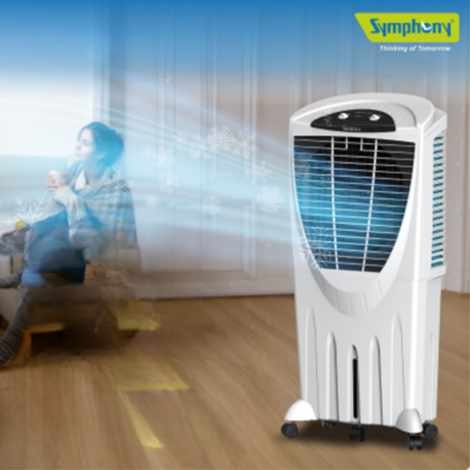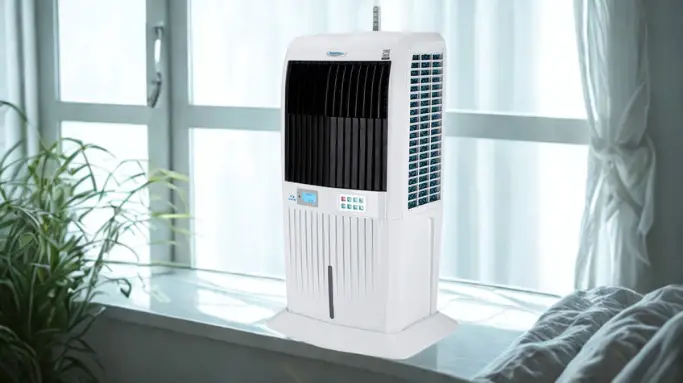As the monsoon season rolls in, it brings a welcome relief from the summer heat, but also presents unique challenges for maintaining your home’s cooling equipment. While air conditioners are often overused during the humid months, air coolers can be a more effective, eco-friendly, and cost-efficient choice for staying comfortable during the rains. However, to keep your air cooler performing optimally, it is essential to maintain it properly. The monsoon season introduces increased moisture, which can impact the functionality of air coolers if they are not cared for properly. In this article, we will guide you through how to maintain your air cooler during the monsoon, so it can continue to provide reliable, efficient, and clean cooling.
Why Monsoon Care for Your Air Cooler is Essential
The monsoon season brings increased humidity and moisture, which can cause various issues for air coolers. If proper care is not taken, these changes can lead to problems like reduced cooling efficiency, clogging, and even mold or mildew growth. Since air coolers rely on water-soaked pads to cool the air, moisture in the environment can have both positive and negative effects. While humidity may enhance the cooling effect of an air cooler, excessive moisture may cause unwanted issues like water stagnation, foul odors, and microbial growth.
For optimal performance and longevity, it is essential to follow a few simple maintenance practices to ensure that your air cooler is working at its best during the monsoon season.
1. Clean the Water Tank Regularly
The water tank in your air cooler is one of the most important components when it comes to efficient performance. During the monsoon, the tank can accumulate dust, grime, and algae growth due to the high moisture in the air. Dirty water can also lead to foul smells and impact the quality of the cool air being circulated. To prevent this, it is important to clean the water tank regularly.
How to clean the water tank:
- Turn off and unplug the air cooler to ensure safety.
- Empty the water tank and use a mild detergent or disinfectant solution to clean the tank thoroughly.
- Use a soft brush or cloth to scrub the inside of the tank to remove any buildup of dirt or algae.
- Rinse the tank well to ensure no detergent or cleaner remains inside.
- Fill the tank with fresh water before restarting the air cooler.
By cleaning the water tank regularly, you ensure that your air cooler continues to provide clean and fresh cool air, free from any contaminants that may have accumulated.
2. Check and Replace the Cooling Pads
Cooling pads are critical for an air cooler’s performance as they absorb water and help cool the air by the process of evaporation. During the monsoon, high humidity can cause the cooling pads to accumulate more moisture, which in turn may lead to mold and mildew growth. These microbial buildups not only affect the air quality but also reduce the efficiency of the cooler.
How to maintain the cooling pads:
- Check the cooling pads regularly for any signs of wear and tear, mold, or mildew.
- Clean the cooling pads every few weeks by using a mild soap solution or vinegar-water mixture to kill bacteria and fungi. Gently wipe the surface to remove dirt.
- If the pads have become too dirty or damaged, consider replacing them entirely. Most air cooler brands provide replacement pads that are easy to install and maintain optimal cooling efficiency.
By taking the time to inspect and maintain the cooling pads, you’ll ensure that your air cooler is performing at its best during the monsoon season.
3. Ensure Proper Ventilation
Even though air coolers are excellent for cooling in humid weather, they still require good ventilation to function efficiently. During the monsoon, many people close windows and doors to keep out the rain. However, a lack of ventilation can reduce the air cooler’s performance.
How to ensure proper ventilation:
- Open windows on the opposite side of the cooler to allow air circulation. This will help the air cooler to pull in fresh outdoor air, which is essential for the cooling process.
- Place the cooler near a window or ventilation opening, ensuring the air can flow freely through the system.
- Avoid sealing the room completely, as the cooler will not be able to circulate fresh air without proper airflow.
By maintaining proper ventilation, you ensure that your air cooler functions efficiently, providing you with a consistent and effective cooling experience even during the rainy season.

4. Maintain the Fan and Pump
The fan and pump are the primary components responsible for the air cooler’s cooling process. If these parts are not functioning properly, your air cooler will not provide optimal cooling, and the overall efficiency will decrease. During the monsoon season, the moisture in the air can sometimes cause the fan and pump to become clogged with dust or debris, which can affect their operation.
How to maintain the fan and pump:
- Check the fan blades for any buildup of dirt, debris, or mold, and clean them with a soft cloth.
- Inspect the pump to ensure that it is working properly. If the pump is clogged, it may prevent water from reaching the cooling pads, reducing the effectiveness of the cooler.
- Lubricate the fan and pump if required, according to the manufacturer’s instructions, to keep them running smoothly.
Proper care and maintenance of the fan and pump ensure that your air cooler continues to provide efficient cooling and that no mechanical issues arise during the monsoon season.
5. Protect Your Air Cooler from Excessive Water Exposure
Although air coolers are designed to use water for cooling, excessive water exposure, such as direct rain or high humidity, can damage the internal components of the cooler. It is important to ensure that your air cooler is protected from external water sources during the monsoon.
How to protect your air cooler from water exposure?
- Place the cooler in a sheltered area, such as a balcony or a covered corner, where it won’t be exposed to direct rain.
- Use a waterproof cover when the cooler is not in use. This helps to keep the internal components dry and prevents damage from excessive moisture.
By keeping your air cooler sheltered from the elements, you protect the motor, fan, and other critical parts from water damage, ensuring longer-lasting performance.
6. Check for Blockages in the Water Line
The water line in your air cooler ensures that the water flows smoothly from the tank to the cooling pads. During the monsoon, it’s essential to check the water line for any blockages, especially since the humid environment can lead to faster accumulation of dirt or mold inside the water lines.
How to check the water line?
- Inspect the water line regularly for any kinks, cracks, or blockages.
- If you notice a blockage, clean the water line by flushing it with a mild cleaning solution to remove any debris or buildup.
- Check for leaks and ensure that the water line is intact for proper functionality.
Proper maintenance of the water line ensures that the cooling pads are consistently supplied with water, which helps maintain the cooler’s performance.
7. Regularly Check the Power Supply and Settings
In the monsoon season, power fluctuations and storms are common. It’s important to regularly check the power supply to ensure that your air cooler is receiving a stable voltage. Power surges can damage the electrical components of your air cooler, especially the motor and control board.
How to check the power supply:
- Ensure that the cooler is plugged into a properly grounded outlet to prevent electrical hazards.
- Use a voltage stabilizer if required, to protect the air cooler from power surges.
- Regularly check the settings on the cooler to make sure the fan speed and water levels are set appropriately for optimal cooling.
By ensuring that the electrical components are protected and properly configured, you can avoid any damage from power surges and ensure consistent performance.
Conclusion
The monsoon season can be tough on your air cooler, but with the right care, it can continue to provide you with cool, fresh, and comfortable air. Regular maintenance, such as cleaning the water tank, replacing cooling pads, ensuring proper ventilation, and checking for blockages, can help your air cooler perform at its best. By following these simple maintenance tips, you can extend the life of your air cooler, avoid common issues, and continue enjoying optimal performance throughout the monsoon season.
Proper care and maintenance not only enhance the efficiency of your air cooler but also ensure that you stay comfortable and healthy in the damp and humid environment of the rainy season. Take the necessary steps to keep your air cooler in top shape, and you’ll enjoy reliable cooling throughout the monsoon and beyond.
FAQs on Monsoon Care for Your Air Cooler
Q1: Why is it important to clean the water tank during the monsoon season?
The water tank can accumulate dust, dirt, and algae due to increased humidity during the monsoon. Cleaning the tank regularly ensures that your air cooler provides clean, fresh, and odor-free air, preventing microbial growth and foul smells.
Q2: How often should I replace the cooling pads during the rainy season?
It’s recommended to check the cooling pads every month during the monsoon season. If the pads are clogged with dirt or show signs of mold, replace them immediately. Regular maintenance will help maintain optimal performance and avoid a reduction in cooling efficiency.
Q3: Can I use my air cooler without proper ventilation during the monsoon?
While air coolers work well in humid environments, proper ventilation is still necessary for effective cooling. During the monsoon, ensure that windows or ventilation openings are open for fresh air circulation, which helps the air cooler perform efficiently.
Q4: How can I prevent mold growth in my air cooler during the rainy season?
To prevent mold growth, clean the water tank and cooling pads regularly. Avoid allowing water to stagnate, and make sure to dry the interior components when not in use. Keeping your cooler in a dry, sheltered spot will also help reduce exposure to excess moisture.
Q5: Is it safe to leave my air cooler outdoors during the monsoon?
It’s not advisable to leave your air cooler exposed to rain or excessive moisture. Place the cooler in a sheltered area to protect the internal components from damage. Use a waterproof cover when not in use to keep it safe from the elements.
Q6: How do I ensure my air cooler is running efficiently during the monsoon?
Regularly check and clean the water tank, replace cooling pads when necessary, and ensure proper airflow by keeping windows or vents open. Also, inspect the fan, pump, and water lines for any blockages to maintain consistent cooling performance.
